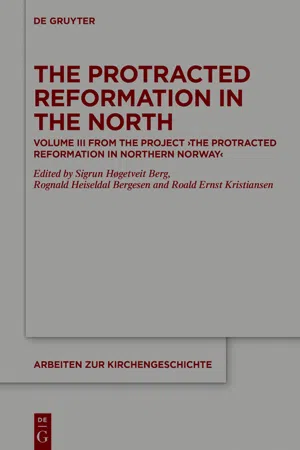
The Protracted Reformation in the North
Volume III from the Project "The Protracted Reformation in Northern Norway" (PRiNN)
- 422 pages
- English
- ePUB (mobile friendly)
- Available on iOS & Android
The Protracted Reformation in the North
Volume III from the Project "The Protracted Reformation in Northern Norway" (PRiNN)
About This Book
The formation of the European nation states was deeply affected by the Reformation processes during the 16th century. In order to understand today's Europe, it is necessary to come to terms with the historical processes that shaped these emerging nation states. The book discusses such processes with particular attention to how they affected the northernmost parts of Europe. The book consists of three main parts: 1) Church and State, 2) Interaction and Networks, 3) Ideas and Images. In the first part, the authors examine various aspects of the relationship between the church and the state, and how the Reformation processes contributed to reshape this relationship. In the second part, the development of the social and economic networks among the population of Northern Fennoscandia is mapped, taking account of how such networks were affected by different ethnic groups. The role of the church and the mission in the state integration of the Northern borderless areas is also examined, as well as the new Lutheran clergy and their social and material conditions. In the third part, the visual and material expressions of the Reformation period is analyzed, as well as the encounter between the Catholic, the Lutheran and the Sámi religion.
Frequently asked questions
Information
Part I: Church and State
A Matter of the Learned: Ways of Reformation Knowledge from Germany to the North
Medieval Universities in Scandinavia
Uppsala
Lund
Copenhagen
Preliminary Conclusion
- Latin worked very well as a lingua franca in medieval European higher education. When the so-called Wiener Schule around Johann von Neumarkt and Nikolaus von Dinkelsbühl started to read and write academic works of theology in the German vernacular towards the end of the fourteenth century, this was a massive innovation in an otherwise completely Latin context.
- Students travelling often and over long distances to a university town was common in medieval times. The attachment of universities to individual princes was not as important in the Middle Ages as it was later in early modern times, when territorial princes, running territorial churches, wanted to establish territorial universities in order to have a regional intellectual elite sharing their Christian denomination.
- Scandinavians were great travelers in general. According to the research of Christian Krötzl2 (2001), we can picture a very well-developed medieval system of travel on the Baltic and in the coastal regions of the North Sea. By the year 1517, a German student would have the choice between the universities of Prague, Vienna, Erfurt, Heidelberg, Cologne, Würzburg, Leipzig, Rostock, Trier, Greifswald, Freiburg, Ingolstadt, Mainz, Tübingen, Frankfurt/Oder, and Wittenberg – sixteen institutions. With an annual or even semestrial home leave, this meant a walking distance from most areas in the German-speaking realms. Therefore, German students were often able to travel as wanderers, whereas Scandinavians were deemed to develop an identity as a passenger if they did not come from Sjælland – it was not possible to reach Copenhagen without a boat and it was rather arduous to leave Norway without one. However, in being great travelers, Scandinavian students did not limit themselves to Copenhagen. Three medieval German universities, Rostock, Greifswald, and Frankfurt an der Oder, were more or less easily accessible from Scandinavia via the Baltic Sea. Looking at the rolls of Rostock and Greifswald, we can see that many Scandinavians made that choice.3 The epitome of these medieval peregrinationes academicae is the one of Olav Engelbrektsson. Probably from Northern Norway (his family can be located at Trondenes), he was enrolled at Rostock in 1503 and graduated from this university as a bachelor in 1505 and a master in 1507. In doing so, he was extraordinarily keen but not extraordinarily footloose. Although studying in general was an expensive and rare enterprise, we should take into account that those Scandinavians who did study in the Middle Ages took journeys of the same or even greater length for lesser academic honors. (See Fig. 1.)

Universities in the Period of the Reformation
Table of contents
- Title Page
- Copyright
- Contents
- Introduction
- Part I: Church and State
- Part II: Interaction and Networks
- Part III: Ideas and Images
- Index of Subjects
- Index of Names
- Index of Places